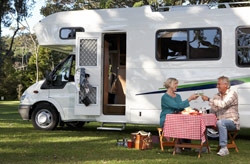With restricted space and resources, RVers and campers are natural conservers while traveling. Utilizing standard energy conservation and environmentally friendly practices, RV enthusiasts live the three Rs—reducing, reusing and recycling.
RVs have a limited supply of water, so RVers are naturally frugal about the amount used. Many RVers conserve water by taking “military showers,” or showers in which water is only running while rinsing. Employing the “military shower” technique can cut water usage from about 17.2 gallons to 5 gallons or less, especially beneficial if you have a small hot water tank. For a (very) quick post hike rinse, a solar camp shower is a decent, inexpensive option.
 It’s common for RVers to use the natural environment as a method to providing basic necessities such as light, heat and air in order to save energy. The sun’s blaze can be utilized instead of turning on lights and heat, opening a window on a cool day can replace air conditioning, and cooking over a campfire or solar stove instead of a conventional electrical stove. Many RV and camping enthusiasts reduce their carbon footprints by recycling plastic containers.
It’s common for RVers to use the natural environment as a method to providing basic necessities such as light, heat and air in order to save energy. The sun’s blaze can be utilized instead of turning on lights and heat, opening a window on a cool day can replace air conditioning, and cooking over a campfire or solar stove instead of a conventional electrical stove. Many RV and camping enthusiasts reduce their carbon footprints by recycling plastic containers.
Solar energy is one of the, all pun intended, hottest RV eco-equipment on the market. An increasingly popular trend in conserving energy and cutting greenhouse gas emissions, 20 percent of RV owners utilize the power of the sun to charge the RV’s batteries, and all the basic lighting and appliances.
Ways to go green while RVing or camping include:
- Using non-toxic, natural cleaning supplies—for the vehicle and you.
- Recycling along the way by utilizing campground or local recycling areas.
- Using reusable plates, cups and glasses, utensils, cloth napkins and containers.
- Switching out traditional light bulbs for longer lasting, more efficient LED lights.
- Driving at or under the speed limit will save gasoline.
- Investing in solar power chargers for any mobile or electronic devices. Even better? Don’t bring them.
Many new RVs are coming to showrooms leaner and greener then before, thanks to advances in manufacturing practices including improved aerodynamic designs, fuel efficiency and lighter composite materials, plus the use of eco-friendly sealants and recycled or renewable materials in interior construction.
